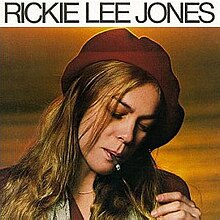Rickie Lee Jones (album)
This article has multiple issues. Please help improve it or discuss these issues on the talk page. (Learn how and when to remove these messages)
|
| Rickie Lee Jones | ||||
|---|---|---|---|---|
 | ||||
| Studio album by | ||||
| Released | February 28, 1979 | |||
| Recorded | September–December 1978 | |||
| Studio | Warner Bros. Recording Studios and The Burbank Studios Tracks 2, 11 recorded live December 22, 1978 at TBS | |||
| Genre | Rock | |||
| Length | 42:11 | |||
| Label | Warner Bros. | |||
| Producer | Lenny Waronker, Russ Titelman | |||
| Rickie Lee Jones chronology | ||||
| ||||
Rickie Lee Jones is the debut album of singer-songwriter Rickie Lee Jones, released in 1979.
Background
Jones had begun playing live in the Los Angeles area at the age of 21, and after meeting singer-songwriter Alfred Johnson, the pair began writing and performing live together (most notably at the Ala Carte club.) Two of their collaborations, "Weasel and the White Boys Cool" and "Company," would later be recorded for Jones' debut album. She also sang jazz standards, as well as a song penned by her father ("The Moon Is Made of Gold") in her live sets.
Jones' performances around Los Angeles aroused interest from other local songwriters, as well as local record company executives. At a label showcase, Jones performed originals, including "Chuck E.'s in Love", "The Real Thing Is Back in Town" and "The Moon Is Made of Gold." This showcase performance, plus a demo containing "The Last Chance Texaco", "Easy Money", "Young Blood" and "After Hours" led to a record deal with Warner Bros.. For her major label debut, Jones scrapped "The Real Thing Is Back in Town," but used the titular line in one of the album's tracks - "Coolsville."
Recording sessions (which began in September 1978) yielded eleven songs for inclusion on an album. Two of the songs - "On Saturday Afternoons in 1963" and "After Hours" - were recorded live on December 22, 1978.
Reception
| Review scores | |
|---|---|
| Source | Rating |
| AllMusic | |
| Smash Hits | 8/10[2] |
| The Village Voice | B−[3] |
The album was released in the spring of 1979 to mostly favorable reviews, propelled by the single "Chuck E.'s in Love". The single became a US #4 hit during the summer, while the album, which went on to become a million seller, hit US #3. Jones was supported by a performance on Saturday Night Live in April 1979, where she performed "Chuck E.'s in Love" and "Coolsville". A second single, "Young Blood," cracked the US Top 40 in late 1979, when Jones went on an international tour. By June 1981, the album had sold over two million copies in the U.S.
Image
The album cover photography and design was by Norman Seeff.
Awards
| Year | Nominee / work | Award | Result |
|---|---|---|---|
| 1980 | |||
| Rickie Lee Jones | Best New Artist | Won | |
| "Chuck E.'s In Love" | Best Pop Vocal Performance, Female | Nominated | |
| Song of the Year | Nominated | ||
| "The Last Chance Texaco" | Best Rock Vocal Performance, Female | Nominated | |
| Tom Knox[4] | Best Engineered Recording - Non-Classical | Nominated |
Track listing
Songs written by Rickie Lee Jones, except where noted.
- "Chuck E.'s in Love" 3:28
- "On Saturday Afternoons in 1963" – 2:31
- "Night Train" – 3:14
- "Young Blood" – 4:04
- "Easy Money" – 3:16
- "The Last Chance Texaco" – 4:05
- "Danny's All-Star Joint" – 4:01
- "Coolsville" – 3:49
- "Weasel and the White Boys Cool" (Rickie Lee Jones, Alfred Johnson) – 6:00
- "Company" (Rickie Lee Jones, Alfred Johnson) – 4:40
- "After Hours (Twelve Bars Past Goodnight)" – 2:13
Personnel
- Rickie Lee Jones – vocals, keyboards, percussion, guitar, horn arrangements
- Dr. John – keyboards
- Michael McDonald – vocals
- Randy Newman – synthesizer
- Victor Feldman – percussion, drums, keyboards
- Tom Scott – horns
- Ralph Grierson – keyboards
- Michael Boddicker – synthesizer
- Red Callender – bass
- Nick DeCaro – accordion, orchestral arrangements
- Buzz Feiten – guitar
- Chuck Findley – horns
- Steve Gadd – drums
- Randy Kerber – keyboards
- Neil Larsen – keyboards
- Arno Lucas – background vocals
- Johnny Mandel – orchestral arrangements
- Andy Newmark – drums
- Jeff Porcaro – drums
- Leslie Smith – background vocals
- Mark Stevens – drums, percussion
- Fred Tackett – guitar, mandolin
- Joe Turano – background vocals
- Ernie Watts – horns
- Willie Weeks – bass
- Matthew Weiner – background vocals
- Technical
- Lee Herschberg, Loyd Clifft – engineer
- Mike Salisbury – art direction, cover design
- Norman Seeff – photography
Charts
Weekly charts
Year-end charts
|
Singles - Billboard
|
Sample
Notes
- ^ Ruhlmann, William. "Rickie Lee Jones – Rickie Lee Jones". AllMusic. Retrieved December 8, 2020.
- ^ Starr, Red (August 9–22, 1979). "Albums". Smash Hits. Vol. 1, no. 18. p. 25.
- ^ Christgau, Robert (April 30, 1979). "Christgau's Consumer Guide". The Village Voice. Retrieved September 20, 2012.
- ^ https://www.grammy.com/grammys/artists/tom-knox
- ^ Kent, David (1993). Australian Chart Book 1970–1992 (illustrated ed.). St Ives, N.S.W.: Australian Chart Book. p. 431. ISBN 0-646-11917-6.

